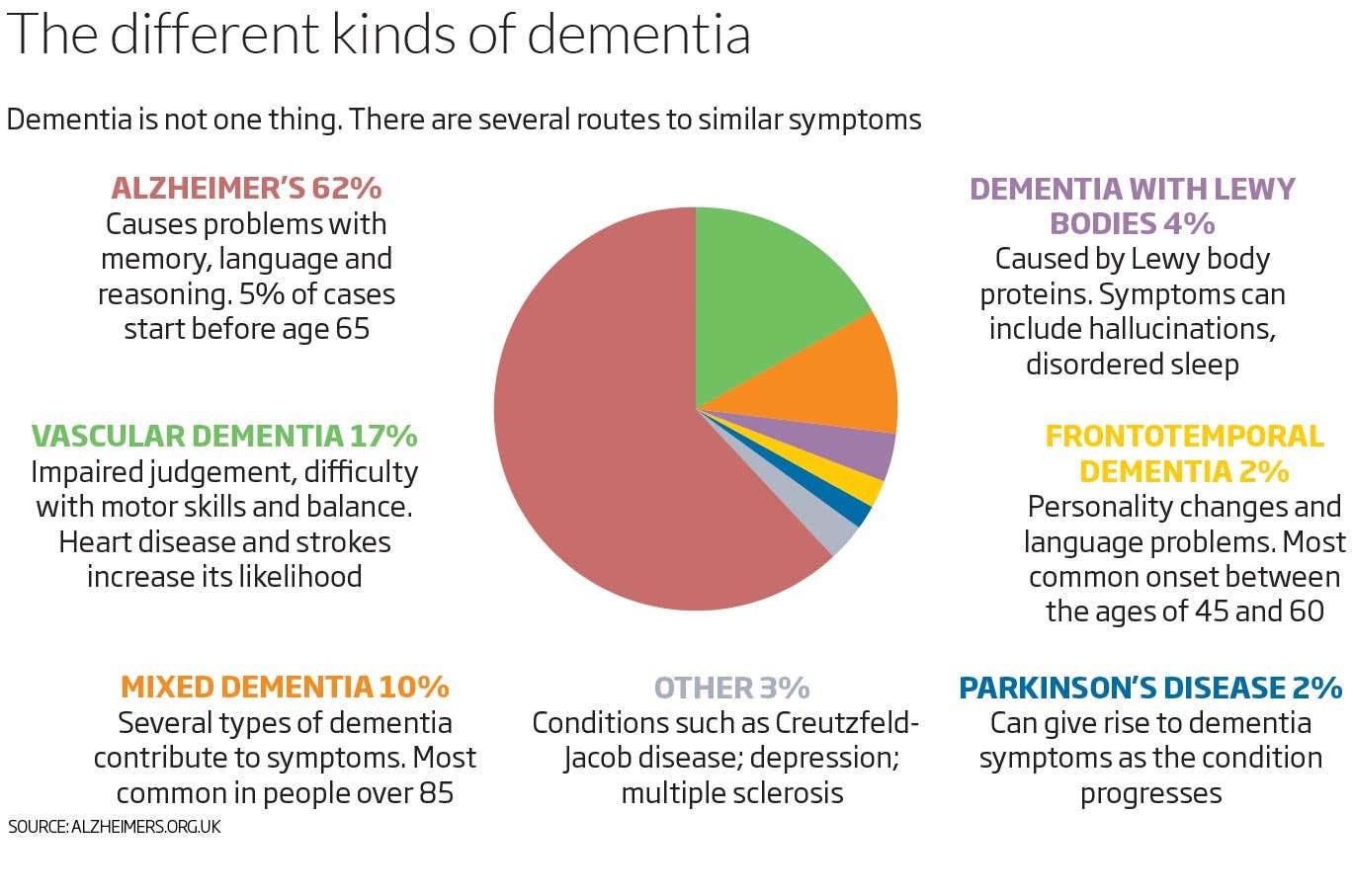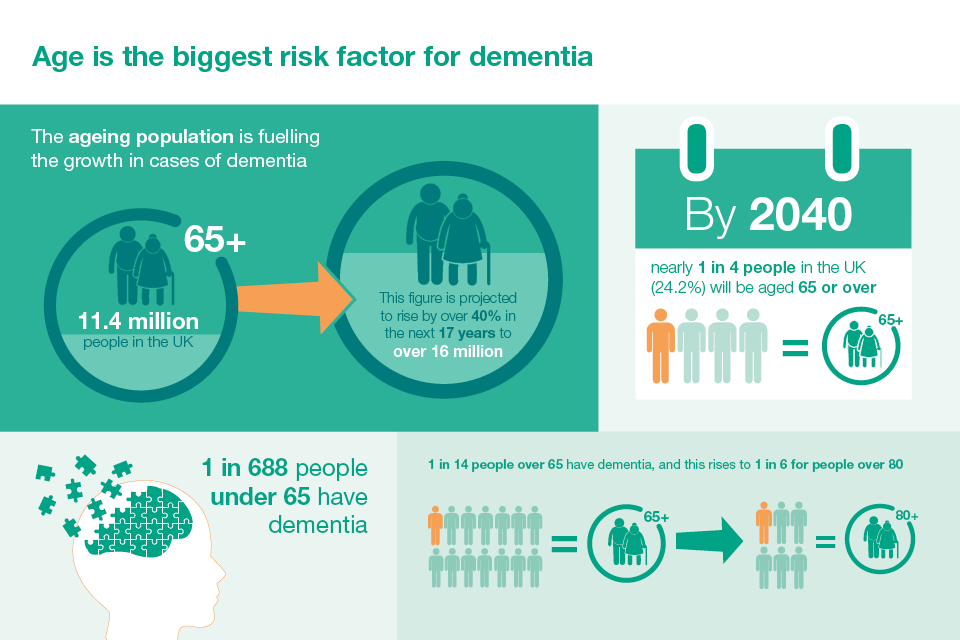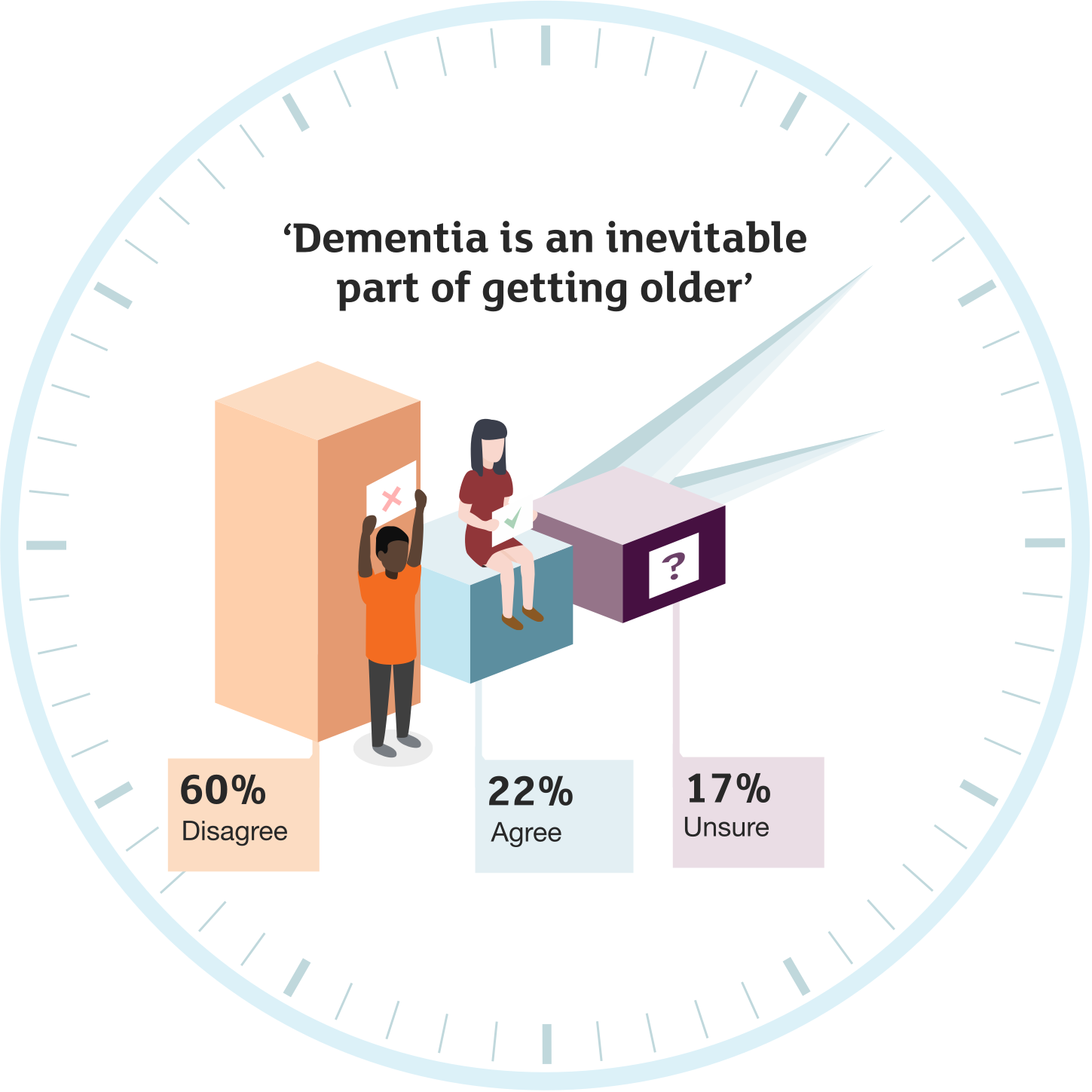How Is Dementia Treated
Treatment of dementia depends on the underlying cause. Neurodegenerative dementias, like Alzheimers disease, have no cure, though there are medications that can help protect the brain or manage symptoms such as anxiety or behavior changes. Research to develop more treatment options is ongoing.
Leading a healthy lifestyle, including regular exercise, healthy eating, and maintaining social contacts, decreases chances of developing chronic diseases and may reduce number of people with dementia.
What Are The Most Common Types Of Dementia
- Alzheimers disease. This is the most common cause of dementia, accounting for 60 to 80 percent of cases. It is caused by specific changes in the brain. The trademark symptom is trouble remembering recent events, such as a conversation that occurred minutes or hours ago, while difficulty remembering more distant memories occurs later in the disease. Other concerns like difficulty with walking or talking or personality changes also come later. Family history is the most important risk factor. Having a first-degree relative with Alzheimers disease increases the risk of developing it by 10 to 30 percent.
- Vascular dementia. About 10 percent of dementia cases are linked to strokes or other issues with blood flow to the brain. Diabetes, high blood pressure and high cholesterol are also risk factors. Symptoms vary depending on the area and size of the brain impacted. The disease progresses in a step-wise fashion, meaning symptoms will suddenly get worse as the individual gets more strokes or mini-strokes.
- Lewy body dementia. In addition to more typical symptoms like memory loss, people with this form of dementia may have movement or balance problems like stiffness or trembling. Many people also experience changes in alertness including daytime sleepiness, confusion or staring spells. They may also have trouble sleeping at night or may experience visual hallucinations .
What Increases The Risk For Dementia
- AgeThe strongest known risk factor for dementia is increasing age, with most cases affecting those of 65 years and older
- Family historyThose who have parents or siblings with dementia are more likely to develop dementia themselves.
- Race/ethnicityOlder African Americans are twice more likely to have dementia than whites. Hispanics 1.5 times more likely to have dementia than whites.
- Poor heart healthHigh blood pressure, high cholesterol, and smoking increase the risk of dementia if not treated properly.
- Traumatic brain injuryHead injuries can increase the risk of dementia, especially if they are severe or occur repeatedly.
Read Also: Sleeping Pills Cause Dementia
What To Do If A Loved One Is Suspicious Of Having Dementia
- Discuss with loved one. Talk about seeing a medical provider about the observed changes soon. Talk about the issue of driving and always carrying an ID.
- Medical assessment. Be with a provider that you are comfortable with. Ask about the Medicare Annual Wellness exam.
- Family Meeting. Start planning, and gather documents like the Health Care Directive, Durable Power of Attorney for Health Care, Estate Plan.
Overview Of Alzheimer’s Disease

Alzheimer’s disease is a type of brain disease, just as coronary artery disease is a type of heart disease. It is also a degenerative disease, meaning that it becomes worse with time. Alzheimer’s disease is thought to begin 20 years or more before symptoms arise,- with changes in the brain that are unnoticeable to the person affected. Only after years of brain changes do individuals experience noticeable symptoms such as memory loss and language problems. Symptoms occur because nerve cells in parts of the brain involved in thinking, learning and memory have been damaged or destroyed. As the disease progresses, neurons in other parts of the brain are damaged or destroyed. Eventually, nerve cells in parts of the brain that enable a person to carry out basic bodily functions, such as walking and swallowing, are affected. Individuals become bed-bound and require around-the-clock care. Alzheimer’s disease is ultimately fatal.
Read Also: What Color Ribbon Is Alzheimer’s
How Dementia Affects People Worldwide
Of the 47.5 million people living with dementia, approximately 58 percent are living within low and middle-income countries. The rates of this syndrome are expected to continually rise, with estimates as high as 75.6 million cases by 2030 and a shocking 135.5 million by 2050.
A recent meta-analysis reported that the global prevalence of dementia is somewhere between 5 and 7 percent within people aged 60 or over. By the age of 85 years and older, between 25 and 50 percent of people display symptoms of dementia, more specifically Alzheimers.
Us Dementia Rates Are Dropping Even As Population Ages
By Gina Kolata
Despite fears that dementia rates were going to explode as the population grows older and fatter, and has more diabetes and high blood pressure, a large nationally representative survey has found the reverse. Dementia is actually on the wane. And when people do get dementia, they get it at older and older ages.
Previous studies found the same trend but involved much smaller and less diverse populations like the mostly white population of Framingham, Mass., and residents of a few areas in England and Wales.
The new study found that the dementia rate in Americans 65 and older fell by 24 percent over 12 years, to 8.8 percent in 2012 from 11.6 percent in 2000. That trend is statistically significant and impressive, said Samuel Preston, a demographer at the University of Pennsylvania who was not associated with the study.
In 2000, people received a diagnosis of dementia at an average age of 80.7 in 2012, the average age was 82.4.
The dementia rate is not immutable, said Dr. Richard Hodes, director of the National Institute on Aging. It can change.
And that is very good news, said John Haaga, director of the institutes division of behavioral and social research. It means, he said, that roughly a million and a half people aged 65 and older who do not have dementia now would have had it if the rate in 2000 had been in place.
New Alzheimers Disease Treatment Approved
Participants also were asked about their education levels, income and health.
Also Check: What Color Ribbon Is Alzheimer’s
Do All Elderly People Become Affected By Dementia
By Doris Kasold 9 am on December 25, 2018
According to statistics, more than 35 million older adults are affected by dementia worldwide. The number includes more than four million seniors in the United States. Many believe dementia is a normal consequence of aging, but that belief is incorrect. Several factors determine the prospect of developing cognitive impairment.
Struggling To Adapt To Change
For someone in the early stages of dementia, the experience can cause fear. Suddenly, they cant remember people they know or follow what others are saying. They cant remember why they went to the store, and they get lost on the way home.
Because of this, they might crave routine and be afraid to try new experiences. Difficulty adapting to change is also a typical symptom of early dementia.
Read Also: Does Prevagen Work For Dementia
Trends In The Prevalence And Incidence Of Alzheimer’s Dementia Over Time
A growing number of studies indicate that the prevalence, – and incidence, , – of Alzheimer’s and other dementias in the United States and other higher-income Western countries may have declined in the past 25 years,, , – though results are mixed., , , These declines have been attributed to increasing levels of education and improved control of cardiovascular risk factors., , , , , Such findings are promising and suggest that identifying and reducing risk factors for Alzheimer’s and other dementias may be effective. Although these findings indicate that a person’s risk of dementia at any given age may be decreasing slightly, the total number of people with Alzheimer’s or other dementias in the United States and other high-income Western countries is expected to continue to increase dramatically because of the increase in the number of people at the oldest ages.
3.7.1 Looking to the future: Aging of the baby boom generation
- By 2025, the number of people age 65 and older with Alzheimer’s dementia is projected to reach 7.1 million â almost a 22% increase from the 5.8 million age 65 and older affected in 2020.,
- By 2050, the number of people age 65 and older with Alzheimer’s dementia is projected to reach 13.8 million, barring the development of medical breakthroughs to prevent, slow or cure Alzheimer’s disease.,
FIGURE 5
What Is Dementia And What Is Alzheimer’s Disease
Dementia refers to a set of symptoms and signs associated with a progressive deterioration of cognitive functions that affects daily activities. It is caused by various brain diseases and injuries. Alzheimer’s disease is the most common cause of dementia. Vascular dementia, frontotemporal dementia, and Lewy body dementia constitute other common types. Symptoms of dementia can include memory loss, judgement and reasoning problems, and changes in behaviour, mood and communication abilities.Footnote 4
You May Like: Color For Alzheimer’s Ribbon
Alzheimer’s Disease Or Dementia
Many people wonder what the difference is between Alzheimer’s disease and dementia.
Dementia is an overall term for a particular group of symptoms. The characteristic symptoms of dementia are difficulties with memory, language, problem-solving and other thinking skills that affect a person’s ability to perform everyday activities. Dementia has many causes . Alzheimer’s disease is the most common cause of dementia.
According To National Data Of People 65+:

- Over 432,000 seniors live with diagnosed dementia.
- 2/3 are women.
- The percentage of seniors living with dementia increased by 9% in 10 years.
- 9 seniors are diagnosed with dementia every hour.
- The risk of being diagnosed with dementia doubles with every 5 year increase in age, between the ages of 65 and 84.
- The all-cause mortality rate in seniors with diagnosed dementia is 4.4 times higher than that of seniors without.
Also Check: What Color Ribbon Is Alzheimer’s
Analyses Of Disability Aging And Long
This report was prepared under contract #HHSP233201600021I between the U.S. Department of Health and Human Services , Office of Disability, Aging and Long-Term Care Policy and RTI International. For additional information about this subject, you can visit the DALTCP home page at or contact the ASPE Project Officer, Helen Lamont, at HHS/ASPE/DALTCP, Room 424E, H.H. Humphrey Building, 200 Independence Avenue, SW, Washington, DC 20201. Her e-mail address is: .
Reports Available
Dementia Cases Expected To Triple By 2050 As World Population Ages
Across the globe, more than 35 million people are living with dementia, according to recent World Health Organization estimates.1 This number is expected to more than triple to reach 115 million by 2050 in the wake of world population aging.
Fueled by declines in fertility and increases in life expectancy, the share of the worlds population ages 65 and older is on track to jump from 8 percent today to nearly 17 percent in 2050, according to new U.S. Census Bureau population projections.
Dementia is a brain disease characterized by loss of memory, speech, reasoning, and other cognitive functions Alzheimers disease is the most common form likely accounting for 70 percent of all cases. The onset of dementia is devastating for individuals and their families, profoundly affecting the quality of life and taking a severe economic toll. Treating and caring for people with dementia currently costs more than US$600 billion per year worldwide , according to WHO. This estimate includes the cost of providing health and social care as well as the reduction or loss of income of people with dementia and their caregivers.
Projected Numbers of People With Dementia, by Country Income Level, 2010 to 2050
Alzheimers Disease International, World Alzheimer Report 2010, accessed on July 11, 2012.
Don’t Miss: Alzheimer Vs Dementia Vs Senility
Specific Information In This Report
Alzheimer’s Disease Facts and Figures
- Brain changes that occur with Alzheimer’s disease.
- Risk factors for Alzheimer’s dementia.
- Number of Americans with Alzheimer’s dementia nationally and for each state.
- Lifetime risk for developing Alzheimer’s dementia.
- Proportion of women and men with Alzheimer’s and other dementias.
- Number of deaths due to Alzheimer’s disease nationally and for each state, and death rates by age.
- Number of family caregivers, hours of care provided, and economic value of unpaid care nationally and for each state.
- The impact of caregiving on caregivers.
- National cost of care for individuals with Alzheimer’s or other dementias, including costs paid by Medicare and Medicaid and costs paid out of pocket.
- Medicare payments for people with dementia compared with people without dementia.
- Number of geriatricians needed by state in 2050.
The Appendices detail sources and methods used to derive statistics in this report.
When possible, specific information about Alzheimer’s disease is provided in other cases, the reference may be a more general one of âAlzheimer’s or other dementias.â
Risk Factors For Alzheimer’s Dementia
The vast majority of people who develop Alzheimer’s dementia are age 65 or older. This is called late-onset Alzheimer’s. Experts believe that Alzheimer’s, like other common chronic diseases, develops as a result of multiple factors rather than a single cause. Exceptions are cases of Alzheimer’s related to uncommon genetic changes that increase risk.
2.7.1 Age, genetics and family history
The greatest risk factors for late-onset Alzheimer’s are older age,, genetics, and having a family history of Alzheimer’s.-
Age
Age is the greatest of these three risk factors. As noted in the Prevalence section, the percentage of people with Alzheimer’s dementia increases dramatically with age: 3% of people age 65-74, 17% of people age 75-84 and 32% of people age 85 or older have Alzheimer’s dementia. It is important to note that Alzheimer’s dementia is not a normal part of aging, and older age alone is not sufficient to cause Alzheimer’s dementia.
Genetics
| APOE Pair |
|---|
- One in 10 people age 65 and older has Alzheimer’s dementia.,,
- The percentage of people with Alzheimer’s dementia increases with age: 3% of people age 65-74, 17% of people age 75-84, and 32% of people age 85 and older have Alzheimer’s dementia. People younger than 65 can also develop Alzheimer’s dementia, but it is much less common and prevalence is uncertain.
3.1.1 Underdiagnosis of Alzheimer’s and other dementias in the primary care setting
3.1.2 Prevalence of subjective cognitive decline
Don’t Miss: Shampoos That Cause Alzheimer’s
Highlights From The Canadian Chronic Disease Surveillance System
According to the World Health Organization, 47.5 million people live with dementia, including Alzheimer’s disease, worldwide.Footnote 1 As these conditions progress, they become highly debilitating for affected individuals and lead to major health impacts. With a growing and aging population, the number of Canadians living with dementiaFootnote i is expected to increase in future decades, with corresponding implications for health care needs and use. By 2031, it is projected that the total annual health care costs for Canadians with dementia will have doubled those from two decades earlier, from $8.3 billion to $16.6 billion.Footnote 2
Using data from the Canadian Chronic Disease Surveillance System , the Public Health Agency of Canada is able to conduct national surveillance for diagnosed dementia, including Alzheimer’s disease, to support the planning and evaluation of related policies, programs, and services. This fact sheet presents an overview of these new estimates on diagnosed dementia and highlights information on associated health impacts collected through the National Population Health Study of Neurological Conditions.Footnote 3
Risk Factors And Prevention
Although age is the strongest known risk factor for dementia, it is not an inevitable consequence of ageing. Further, dementia does not exclusively affect older people young onset dementia accounts for up to 9% of cases. Studies show that people can reduce their risk of dementia by getting regular exercise, not smoking, avoiding harmful use of alcohol, controlling their weight, eating a healthy diet, and maintaining healthy blood pressure, cholesterol and blood sugar levels. Additional risk factors include depression, low educational attainment, social isolation, and cognitive inactivity.
Don’t Miss: What Color Represents Dementia
Total Cost Of Health Care And Long
Table reports the average annual per-person payments for health care and long-term care services for Medicare beneficiaries age 65 and older with and without Alzheimer’s or other dementias. Total per-person health care and long-term care payments in 2019 from all sources for Medicare beneficiaries with Alzheimer’s or other dementias were over three times as great as payments for other Medicare beneficiaries in the same age group .,
| Payment Source | ||
|---|---|---|
| 2,395 | ||
| TOTAL* Payments from sources do not equal total payments exactly due to the effects of population weighting. Payments for all beneficiaries with Alzheimer’s or other dementias include payments for community-dwelling and facility-dwelling beneficiaries. | 50,201 | 14,326 |
- * Payments from sources do not equal total payments exactly due to the effects of population weighting. Payments for all beneficiaries with Alzheimer’s or other dementias include payments for community-dwelling and facility-dwelling beneficiaries.
- Created from unpublished data from the Medicare Current Beneficiary Survey for 2011.
When Should I Speak To A Doctor About Dementia

See your doctor for a full examination if you notice several of these signs:
Its important not to assume someone has dementia based on these symptoms alone. Other treatable conditions such as depression, infections, hormone imbalances and nutritional deficiencies can also cause dementia-like symptoms.
Read Also: What Color Ribbon Is Alzheimer’s